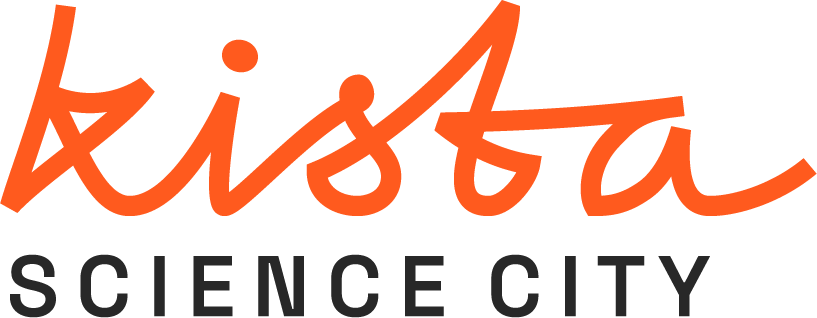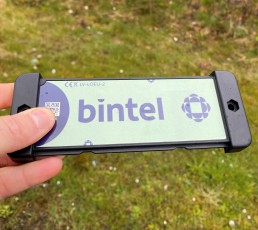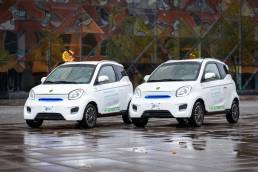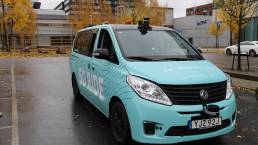The Internet of Things paves the way for smarter waste management in Rinkeby-Kista
I projektet Smart sophantering testar och utvärderar stadsdelen Rinkeby-Kista i samarbete med Urban ICT Arena och två tjänsteleverantörer lösningar för smartare sophantering. Målsättningen är att skapa en renare och mer hållbar stad.
Att kunna styra avfallshanteringen bättre ger också fördelar som lägre kostnader, mindre slitage, bättre arbetsmiljö och minskad miljöpåverkan i flera led.
För att samla in så mycket lärdom som möjligt, och för att testa olika tekniker, deltar också två företag som arbetar avfallshanteringslösningar baserade på sensordata. Det är Norrsidans Innovation som tidigare har utvärderat sin teknik i Urban ICT Arenas testbädd längs med Kistagången, och Bintel, ett företag med stor erfarenhet av sensorer och sophanteringslösningar.
Projektet går ut på att placera ut sensorer i 155 papperskorgar på utvalda platser, grönområden, parker, gångar och cykelvägar. Data på fyllnadsgraden i papperskorgarna är tänkt att ge underlag till alternativa lösningar för en smidigare och mer miljövänlig sophantering.
De data man får tillgång till kan exempelvis få till följd att man ser över hur ofta man tömmer, hur många papperskorgar som finns, var de finns och vilken typ av papperskorgar man använder i olika områden. Det projektet kommer fram till ger värdefulla underlag till stadsdelens fortsatta arbete med effektiv avfallshantering.
Sofie Molin, parkingenjör Rinkeby-Kista stadsdelsförvaltning, säger:
”Det finns många incitament att jobba strategiskt och innovativt med just renhållningsfrågor, det handlar om att hitta en balans mellan behov, effektivisering och utförande. Genom att samla in underlag kan vi skapa oss en tydligare bild över vad för typ av insatser som krävs för att vi ska kunna minska nedskräpningen och bidra till en trivsammare utemiljö”.
Mårten Persson på Bintel, ett av de företag som bidrar i projektet, säger:
“Allt fler kommuner och företag har insett betydelsen att kunna nyttja data som underlag i sin verksamhetsutveckling. Redan så här tidigt i projektet börjar kunderna inse att vi kan skapa värde inom flera olika delar av verksamheten. Allt från att minska nerskräpning till att utvärdera entreprenörer, ge underlag till upphandlingar, veta var det verkligen behövs papperskorgar och i vilken storlek.”
Vehicle as a Sensor: Air Quality
Vehicle as a Sensor: Air Quality
Vehicle as a Sensor: Air Quality
Mobile Air Quality Sensors Attached to Vehicles in Kista
The project
Air quality is a matter of life and death affecting the daily lives in our cities. When we collect real-time data of air quality in our connected cities, we could contribute to new solutions and prevent illness. Imagine a future where the bus automatically avoids the most polluted streets or if factories limit their production on certain days, thanks to connected sensors.
In Kista, new sensors for local air quality measurement are tested in a number of projects. In the project Vehicle as a Sensor: Air Quality, Edeva and Smart Sensor Devices explored the possibilities of air quality sensors attached to moving vehicles. The goal was to see how mobile sensors can provide data in ways that complements fixed sensors, and how these two types of measurements interact to provide a better picture of the situation.
Project period
2020
Partners
Kista Science City
Edeva
Smart Sensor Devices
Contact
Eleonor Sjödin Turah
eleonor.sjodinturah@kista.com
Summary
Taking advantage of vehicles used in a last-mile public transport project, Edeva and Smart Sensor Devices tested their air quality sensors by attaching them to the vehicles. This gave them the opportunity to measure both indoor air quality in the vehicles and take GPS-positioned measurements of air quality in the urban environment.
Air quality
The project collected real-time air quality data and use software to visualize and analyze the data. This would test the robustness of the sensors and systems, and how this would work in a real urban setting. The sensors were attached to the vehicles used in the Delta project, taking place between October and December of 2020.
The air quality sensors measured two types of air quality. The sensors from Smart Sensor Devices measured air quality inside the vehicles, while the sensors from Edeva measured air quality in the urban environment around the vehicles. The Edeva readings used GPS positioning to keep track of where those readings were taken, and given a time stamp.
Measurements of air quality are important for different decision-making processes regarding traffic and planning of the urban environments. Many measurements are, however, bound to fixed positions, which will give a snapshot rather than a comprehensive picture of the city. Proving the concept of mobile, GPS-positioned measurements taken continuously will assist municipalities and city authorities in complementing their data in order to have a better foundation for future decisions. Indoor measurements of air quality also helps with this process, as it may give data on how indoor environments are affected by the surrounding environment. It also gives important data about the work environment.
Takebacks
One important takeback from the trials performed within the scope of the project was that it proved to be valuable to measure random, on-demand voyages rather than regular public transports moving on a time table. This enabled measurements on several different locations and times that might otherwise have been missed. It also gives a better picture of “where people are” rather than only the main thoroughfares in an area.
Moving forward
Moving forward, the next steps for the air quality sensors will be to get regular measurements in a larger urban environment. Taking measurements with even shorter intervals, and combining the mobile sensors with fixed sensors at key locations to look more in-depth at certain variables will probably be the optimal combination to provide good data for municipalities and city authorities in the future. This will also provide data over time to see changes from implemented solutions in the environment.
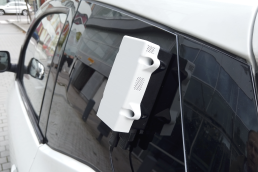
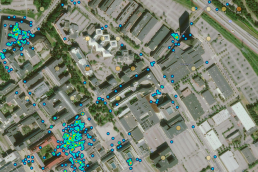
Lessons from the Delta project
The future of mobility will mean new solutions for getting to your destinations. Individual vehicles will become less frequent as we look to more sustainable solutions for mobility, and instead we will see public transport and ridesharing solutions picking up the slack. New solutions for the last mile are launched and tested all the time. One such test was the Delta project in Kista Science City.
The Delta project explored on-demand, last-mile solutions for public transport. Electric cars took users from door to door or connected to public transport hubs in Kista. Booking the ride was done through an app.
As the test was conducted in the autumn of 2020, some constraints had to be added to the test, and the mobility of individuals wasn’t as widespread as usual, but the results are nonetheless promising. In a workshop in January of 2021 the lessons from the tests were presented and we are happy to share them with you.
To set the stage for the project, the projection is that within 10-15 years, connected self-driving vehicles will with all likelihood be a backbone of the modern public transport system. The vehicles used in the Delta project weren’t self-driving, but the concept is made for that context. This also means that when planning new areas for development, preparations should be made both for self-driving solutions in general and ridesharing, on-demand solutions. The latter is something we most likely see more of during those hours where passengers are few and far between, like late nights.
As we look to the lessons learned in the Delta project, we see that the solution tested was mainly used during morning commutes and in the afternoon. As our users were mainly working in Kista, this is not surprising. The commute to and from the workplace, travelling between a public transport hub and the office, seems to be the main reason for utilizing this service. But as this is a last-mile solution, where the alternative to riding is just walking, one thing became evident: having to wait for the ride or not knowing when it would arrive made users cancel their ride. This is important to keep in mind for future implementations of this kind of transport system.
– The on-demand trial from Delta, from technological and customer experience standpoints, is aimed at developing future combined services using free floating on-demand autonomous vehicles, says Sheherazade Zekri, Director New Mobility Services at Keolis.
The big question that needs to be addressed before last-mile solutions of this kind can be rolled out, is the financing. Most users were hesitant to pay for a service like this and wanted it to be included in either the general public transport system, or possibly by their employer or by the real estate company who owns the office building. The business model has been scrutinized and different suggestions have been made, but this is certainly an area that needs to be explored in more detail.
As we look at the bigger picture, with data from a world-wide survey done by Ericsson, we see some interesting patterns in the way people are commuting that fits well with the Delta project and what we learned there. Ride-sharing solutions are popping up in several cities around the globe, and time-efficiency is now the second most important factor when choosing your mode of transportation, after convenience.
The vehicles used for Delta were small, mainly due to the global pandemic putting constraints on how many passengers were prudent to have in one car, but in the evaluations most users were positive to sharing a ride with others. This is something that fits well in with the bigger picture from around the world. Savvy commuters are able to create their own “bubble” while commuting. One large part of this is using digital solutions, listening to music or podcasts, checking social media and so on in order to block out the world around them. This also means that savvy commuters are more satisfied with their commute, even when using traditional modes of public transportation. Being connected in this way also means they are more up to date regarding possible delays or interruptions of services and can more efficiently switch to another mode of transport or take a different route.
– Everyone can relate to the feeling of wasting precious hours every week on a car or a train. So, it is very inspiring to see how some people make the most out of the time when they transition between home and work roles. We have created a unique benchmark to show the benefits of mobile Internet access for a better commuting experience and understand what consumers really want in the future in terms of safety, convenience and entertainment, says Andres Laya, Senior Researcher at Ericsson ConsumerLab.
All in all, attitudes are on the side of the Delta project. Globally, both commuters and city planners agree that ridesharing will contribute to less congestion and reductions of emissions. At the same time, the current opinion is that the private cars will still be needed to some extent, which in part goes against the first opinion. Ridesharing, when it works and is efficient, on-time, convenient and quick will be able to pick up much of the traffic volumes of private cars.
People have come to appreciate the time saved from not commuting every weekday and it is expected that many will continue working from home after the restrictions are lifted. New mobility solutions need to elevate the user experience and allow them to use the travel time to their benefit. For this purpose, connectivity will provide people with the ability to create a better experience for themselves.
Making sure this is the case will be up to projects like Delta.
– The Delta project provided excellent data for how ridesharing last-mile solutions can work in practice and what commuters expect from services like that. It’s been a privilege to assist in this research and the lessons learned have already pointed at some interesting new ways for continued research, development and testing, says Eleonor Sjödin Turah, project manager at Kista Science City.
Testas nu: Ny teknik för framtidens trygga bussresa på självkörande fordon
Innovationsprojektet 5G Ride har testat hur fjärrhantering och nya digitala lösningar kan bidra till en trygg och säker kollektivtrafik med självkörande bussar.
Innovationsprojektet 5G Ride, med deltagarna Urban ICT Arena, Intel, Keolis, Ericsson, T-Engineering, KTH samt Telia utforskar hur 5G, AI och fjärrhantering av fordon via kontrolltorn kan bidra till att underlätta införandet av självkörande eldrivna bussar i stadsmiljöer på ett säkert sätt.
Ambitionen är en effektiv och hållbar kollektivtrafik där operatörer i kontrolltorn kan hantera flottor av autonoma, elektriska fordon för att kunna förbättra trafikplanering och ruttoptimering samt minska energiförbrukning. Det leder till ett mer kostnadseffektivt och miljösmart transportsystem som är mer tillgängligt för invånarna.
Under året har projektet undersökt hur kontrolltornet i kombination med nya digitala tjänster på självkörande bussar kan skapa förutsättningar för en trygg och säker resa för passagerna. Tester har genomförts med självkörande, elektriska fordon i Kista.
– På dagens bussar kan man vända sig till chauffören för hjälp. Det är en trygghet för passagerarna, särskilt för t.ex. äldre. Att man känner sig välkommen och omhändertagen. Med hjälp av ny teknik och kan vi skapa samma upplevelse på självkörande bussar. Det kan handla om att snabbt komma i kontakt med operatörerna i kontrolltorn via enkla digital gränssnitt på bussarna, berättar Jan Jansson, som utvecklar mobilitetstjänster på bussoperatören Keolis.
En annan möjlighet är att med hjälp av AI analysera data från sensorer i bussarna för att proaktivt kunna uppmärksamma operatörerna i kontrolltornet på akuta situationer eller för att identifiera kvarglömda föremål.
Kontrolltornet utvecklas
Förutom att jobba med resan ombord så har även projektet gjort framsteg med att utveckla integrationen mellan kontrolltornet och bussen. Till exempel kan operatören i kontrolltornet ge kommandon till fordonen, och fjärrstyra dem vid behov. Här blir 5G-nätet och dess tekniska egenskaper som snabbhet och korta svarstider viktigt.
Pilottester på Djurgården
5G Ride startade 2020. En viktig milstolpe i projektet var den 24 september samma år då en ny temporär bussrutt invigdes på Djurgården i Stockholm som trafikerades av en eldriven självkörande minibuss uppkopplad mot ett kontrolltorn via 5G-nätet. Projektet kommer fortsätta under kommande år.
Telia invigde Sveriges första storskaliga 5G-nät i maj 2020 i samarbete med Ericsson. Det publika 5G-nätet rullas nu ut runt om i Sverige och kommer täcka mer än 90 % av Sveriges befolkning 2023.
